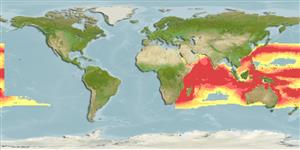Classification / Names
Common names from other countries
Main reference
Size / Weight / Age
Max length : 11.0 cm SL male/unsexed; (Ref. 30434)
Environment
Marine; pelagic-oceanic; depth range 0 - 335 m (Ref. 30434)
Climate / Range
Tropical, preferred ?
Distribution
Short description
Dorsal
spines
(total): 4 - 6;
Dorsal
soft rays
(total): 18-23;
Anal
soft rays: 16 - 21. Chin naked. A row of 5 to 9 pairs of sensory papillae on dorsal surface of head from snout to interorbital. Sensory papillae between eyes not arranged in a semicircle. Ventral margin of pupil indented by tab of iris (Ref 12850).
IUCN Red List Status (Ref. 115185)
Threat to humans
Harmless
Human uses
More information
Common namesSynonymsMetabolismPredatorsEcotoxicologyReproductionMaturitySpawningFecundityEggsEgg development
ReferencesAquacultureAquaculture profileStrainsGeneticsAllele frequenciesHeritabilityDiseasesProcessingMass conversion
Tools
Special reports
Download XML
Internet sources
Estimates of some properties based on models
Phylogenetic diversity index
PD50 = 0.5002 many relatives (e.g. carps) 0.5 - 2.0 few relatives (e.g. lungfishes)
Trophic Level
4.1 ±0.5 se; Based on size and trophs of closest relatives
Resilience
Vulnerability
Low vulnerability (10 of 100)
Price category
